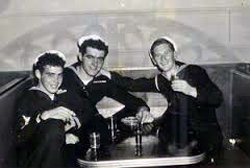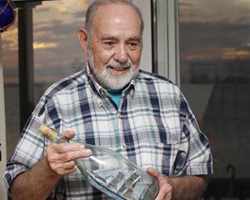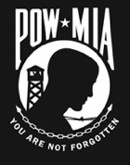
|

|
 | |
|
An up close and personal interview with U.S. Coast Guard Veteran and Togetherweserved.com Member:
BMCM Maurice Poulin U.S. Coast Guard (Ret) (1941-1966)
WHAT INFLUENCED YOUR DECISION TO JOIN THE MILITARY?
 I wanted to be a sailor ever since I was 8 or 10 years old and the Coast Guard had a greater appeal to me because of its size and lifesaving mission. As soon as I reached the required age to join I walked into the Coast Guard recruiting office in Boston, MA and signed up. I then took my oath of enlistment in a ceremony held in New York City's Battery Park. That was in November 1941 and within a day, a handful of us were boarded on a train bound for boot camp in New Orleans, LA. I wanted to be a sailor ever since I was 8 or 10 years old and the Coast Guard had a greater appeal to me because of its size and lifesaving mission. As soon as I reached the required age to join I walked into the Coast Guard recruiting office in Boston, MA and signed up. I then took my oath of enlistment in a ceremony held in New York City's Battery Park. That was in November 1941 and within a day, a handful of us were boarded on a train bound for boot camp in New Orleans, LA.
At the time, Europe had been at war since 1939 but America was none too anxious to be part of it. That is until December 7, 1941 when the Japanese bombed Pearl Harbor and Germany declared war on America three days later. Our boot camp training was accelerated.
WHAT WAS YOUR SERVICE CAREER PATH?
After graduation, I was assigned to the 5th Coast Guard District in Norfolk, VA and sent to the Cape Lookout Lifeboat Station, North Carolina, for guard duty at the radio station. During my short stay at this station in late 1941, we could see when ships were torpedoed offshore. This  was at a time when most Coast Guard stations along the East Coast were sending lifeboats to rescue people from sinking ships. It was a very trying time for me and my shipmates. was at a time when most Coast Guard stations along the East Coast were sending lifeboats to rescue people from sinking ships. It was a very trying time for me and my shipmates.
In March 1942, I was transferred to what was then called Boatswain's Mate School in Manhattan Beach, NY. We spent about six weeks there in training and learning basic seamanship. I was there at the same time when famous boxers Jack Dempsey and Marty Servo were stationed at Manhattan Beach. Many famous sports figures and movie stars left their high paying celerity work and joined the war effort as sailors, soldiers, marines and airmen. World War II was that kind of war: Everyone wanted to do their part.
Aside for a short stay at Cape Lookout Lifeboat Station, I spent over three years aboard the USS Leonard Wood (APA-12), a huge amphibious transport that was 535 feet long with a beam of 72 feet and could carry 32 LVPs and LCVPs (Landing Craft, Vehicle, Personnel or Higgins Boat), two 50 feet tank lighters and two 36 foot support boats. It could also carry nearly 2000 combat troops. Our crew was also large: Sixty officers and 650 crewmen.
I spent a total of 25 years in the US Coast Guard. Among the duty stations I was assigned were 1st Coast Guard District Boston, Coast Guard Station Gay Head Martha's Vineyard and Coast Guard Station Nahant. All the vessels I was assigned were search and rescue and law enforcement cutters: USCGC Duane (WHEC-33/NRDR) and USCGC Caso (WHEC-370) and USCGC Point Cypress (WPB-82326).
I retired in 1966.
DID YOU PARTICIPATE IN COMBAT OPERATIONS? IF SO, COULD YOU DESCRIBE THOSE WHICH WERE SIGNIFICANT TO YOU?
 I saw plenty of combat from the decks of the USS Leonard Wood and while on the sandy beaches of Africa, Italy and the Pacific during nine historical invasions and several smaller landings and assaults. My duty during the invasions was to land with the US Army and Marines as part of the Beach Party to handle operations ashore and interpret for the Beach Party Commander. I saw plenty of combat from the decks of the USS Leonard Wood and while on the sandy beaches of Africa, Italy and the Pacific during nine historical invasions and several smaller landings and assaults. My duty during the invasions was to land with the US Army and Marines as part of the Beach Party to handle operations ashore and interpret for the Beach Party Commander.
My wartime journey begins in April 1942 when I was sent to an old Coast Guard station built in 1874 called the Chicamacomico Life Saving Station near Rodanthe, North Carolina. After staying there two days, I was transferred to the USS Leonard Wood, anchored in Chesapeake Bay off Hampton Roads, Virginia. From April 1942 to June 1945 she was my home.
Our first combat undertaking began in late October 1942 when we departed Hampton Roads carrying 1,900 combat solders from the 3rd Infantry Division for the invasion of North Africa. After two weeks at sea we arrived off the cost of North Africa and on the night of November 7 and 8, we moved in close to beaches at Fedhala, French Morocco. The next morning, some of us went ashore on small boats to provide gun support while other were rescuing survivors from ships torpedoed by German subs during the night. For the next four days our mission of unloading troops and equipment continued. But because German subs had sunk or damaged six Allied ships, we were forced to finish unloading at Casablanca. I was an interpreter for the invasion of North Africa at Casablanca and very proud of being selected for it. We returned to Norfolk for repairs in December 1942.
 Our next operation was Allied invasion of Italy, codenamed Operation Husky. We reached the Italian war zone in late June 1943 at a place called Mers el Kebir, Algeria where we prepared for the assault on Sicily. On July 9, as part of Task Force 65, we began unloading waves of troops some five miles west of Socgglitti, Sicily. The next morning enemy bombers dropped bombs within 300 yards of the Leonard Wood. Our gunners fired on the attacking enemy plane throughout the day, helping to shoot down three aircraft. This photo show the US Robert Rowan exploding after being hit by a German bomber off Gela, Sicily, July 11 1943. Our next operation was Allied invasion of Italy, codenamed Operation Husky. We reached the Italian war zone in late June 1943 at a place called Mers el Kebir, Algeria where we prepared for the assault on Sicily. On July 9, as part of Task Force 65, we began unloading waves of troops some five miles west of Socgglitti, Sicily. The next morning enemy bombers dropped bombs within 300 yards of the Leonard Wood. Our gunners fired on the attacking enemy plane throughout the day, helping to shoot down three aircraft. This photo show the US Robert Rowan exploding after being hit by a German bomber off Gela, Sicily, July 11 1943.
With our unloading complete and damaged landing craft salvaged, Leonard Wood sailed back to our home port of Norfolk Virginia. Thus ending our involvement in the European Theater. But for us the war was far from over. In fact, it was just beginning.
A couple of weeks after arriving to Norfolk, a rumor surfaced claiming we were going to the South Pacific. The rumor turned into reality when we were ordered to sail to San Francisco, pick up troops and set off for Honolulu. We got to Hawaii in late September. We didn't know it then but we had seven amphibious landings ahead of us, all dangerous and deadly.
 Our first amphibious landings were made in the Central Pacific as part of the invasions of the Gilbert and Marshall Islands. We were told the purpose was to establish airfields and supply depots that would allow land base air support for upcoming operation across the central pacific. It began with a costly and bloody three-day battle for the island of Betio at the Tarawa atoll. It was the first time US forces faced serious opposition. The well-supplied and well-prepared Japanese fought to the last man. The US Marines also paid a heavy toll. We could see from the decks of our ship Marine casualties being evacuated and some of the dead being buried. Our first amphibious landings were made in the Central Pacific as part of the invasions of the Gilbert and Marshall Islands. We were told the purpose was to establish airfields and supply depots that would allow land base air support for upcoming operation across the central pacific. It began with a costly and bloody three-day battle for the island of Betio at the Tarawa atoll. It was the first time US forces faced serious opposition. The well-supplied and well-prepared Japanese fought to the last man. The US Marines also paid a heavy toll. We could see from the decks of our ship Marine casualties being evacuated and some of the dead being buried.
This campaign lasted for four months, ending in February 1944. We then returned to Pearl Harbor for three months to refurbish our ship and to get some badly needed rest for our crew.
Again we returned to Pearl Harbor to await our next mission. It came June 1944 as part of the capture and occupation of Saipan in the Marianas Islands. Before reaching Saipan, we stopped at Eniwetok to fuel the ship and to load water and other provisions.
We arrived at Saipan in the middle of June, unloaded American troops in less than an hour. US Marine and Army forces spent three week fighting the Japanese in deadly battles throughout the island. When it was over, nearly all of the 30,000 Japanese defenders were killed and after being told by the Japanese that Americans would torture and kill them, thousands of Japanese civilians killed themselves and their children by jumping off Banzai Cliff to the rock waters below. For the next nine days, we anchored off the coast of Saipan unloading cargo and receiving on board casualties for transfer to hospital ships. We returned to Pearl Harbor at the end of July.
After Saipan, the Leonard Wood made transport and training runs between Pearl Harbor, Eniwetok and Guadalcanal, an island we occupied since capturing it from the Japanese in February 1943. We then sailed to the Angaur Island and Palau Island Group in September and late November 1944 where more than 2,000 Americans and 10,000 Japanese were killed in the deadly Battle of Peleliu.
My crewman and I were getting somewhat battle wearing by this time and were hoping the war would end soon. Instead we were about to embark on our largest Invasion of all: The long-awaited liberation of the Philippines.
 We arrived off the Leyte beachhead on October 20, 1944, offloaded the troops and cargo and steamed back for Palau to pick up more troops and cargo to take back to the Philippines. Our next objective was Lingayen Gulf but on the way there countless Japanese suicide planes attacked of formation. Many Kamikaze pilots were shot out of the air but some got through, crashing on the decks of ships in our convoy. One suicide Kamikaze pilot scored a direct hit on the USS Franklin (show in photo) on March 19, 1945, killing 807 US sailors and wounding 487. Our shipboard antiaircraft guns were firing all the time while we unloading troops and cargo. Our gunners knocked down at least one Japanese plane heading for a destroyer nearby. Once we had unloaded everything, we headed back to Leyte. We arrived off the Leyte beachhead on October 20, 1944, offloaded the troops and cargo and steamed back for Palau to pick up more troops and cargo to take back to the Philippines. Our next objective was Lingayen Gulf but on the way there countless Japanese suicide planes attacked of formation. Many Kamikaze pilots were shot out of the air but some got through, crashing on the decks of ships in our convoy. One suicide Kamikaze pilot scored a direct hit on the USS Franklin (show in photo) on March 19, 1945, killing 807 US sailors and wounding 487. Our shipboard antiaircraft guns were firing all the time while we unloading troops and cargo. Our gunners knocked down at least one Japanese plane heading for a destroyer nearby. Once we had unloaded everything, we headed back to Leyte.
Our last mission in the Philippine Archipelago was the Second Invasion of the Mindoro Island. We off loaded the troops and cargo we were carrying in less than five hours and steamed to San Francisco by way of Leyte and Peal Harbor, arriving at the end of March 1945. Our combat days were over but we were not quite done with transport duties in the Pacific yet. After repairs at San Francisco our ship and crew transported troops and cargo between the United States and the western Pacific on two trips to Manila and one to Tokyo.
FROM YOUR ENTIRE SERVICE CAREER WHAT PARTICULAR MEMORY STANDS OUT?
The North Africa invasion at Fedela, Morocco on Nov. 8, 1942. The enemy for this invasion included troops of France, Germany and Italy. The (Vichy) French manned the heavy guns that fired on the landing forces. German Officers commanded the Vichy French and Italians to resist the invading troops.
I went  into this landing aboard a 3rd Army tank being transported ashore in an LCVP and got ashore safely. Once on the beach, the enemy held us under machine-gun fire, so we all crept low to the ground in our advance. into this landing aboard a 3rd Army tank being transported ashore in an LCVP and got ashore safely. Once on the beach, the enemy held us under machine-gun fire, so we all crept low to the ground in our advance.
Also on the beach with me was Army General George Patton -- who was a two-star (major) general at the time commanding the 3rd Army. I was in a foxhole on the beach a few feet away from him with his aide, who was toting a tommy gun. Patton was larger-than-life; bullets and shells were flying all-around and he was just standing there, exposed, barking orders to his troops on the beach wearing his helmet, tanker jacket, pearl-handled revolvers and riding pants. He was truly a sight to see!
After securing the beachhead, we were then tasked to make sure all supplies and fuel were forwarded to our troops on the line. There were about 35 of us in the Beach Party from several ships and we stayed on the beach for some nine days with the troops. We were continuously under small arms fire and air attacks, and the ships at anchor were enduring torpedo attacks. Five transports were sunk over the next few days with heavy casualties - this was my introduction to the horrors of total war.
WHICH INDIVIDUAL PERSON FROM YOUR SERVICE STANDS OUT AS THE ONE WHO HAD THE BIGGEST IMPACT ON YOU AND WHY?
 I had a great mentor when I was aboard USS Leonard Wood but I must say the one with the biggest impact on me was Chief Boatswain's Mate Robert Kolscher. He was in-charge of 2nd Division aboard the ship. He took me under his wing and mentored me in how to be a good, if not better, seaman. He kept me in-line, and I learned a lot about being a good leader, teacher and mentor from him. I had a great mentor when I was aboard USS Leonard Wood but I must say the one with the biggest impact on me was Chief Boatswain's Mate Robert Kolscher. He was in-charge of 2nd Division aboard the ship. He took me under his wing and mentored me in how to be a good, if not better, seaman. He kept me in-line, and I learned a lot about being a good leader, teacher and mentor from him.
I was also fortunate to have good Officers and Chiefs over me during my entire career. Much of what I passed-on to my shipmates came from their knowledge and wisdom.
WHAT PROFESSION DID YOU FOLLOW AFTER THE SERVICE AND WHAT ARE YOU DOING NOW? IF CURRENTLY SERVING, WHAT IS YOUR CURRENT JOB?
Personally, I'd never liked the idea of retiring completely. Makes you old too fast and cranky when you don't have to be. So I kept up building ships in bottles, a craft I learned to overcome boredom when I was stationed in the Handkerchief lightship in Vineyard sound.  It was terrible living, because most the time it was thick fog and rough waters and our ships never sailed but instead served as stationary foghorns and beacons. It was terrible living, because most the time it was thick fog and rough waters and our ships never sailed but instead served as stationary foghorns and beacons.
Throughout my time since getting out of the Coast Guard, I have build hundreds of ships in the bottles One ship I built is in the Smithsonian, on loan from the Coast Guard Academy Museum. I have another on-display in the Coast Guard Heritage Museum located in Barnstable Village on Cape Cod, MA. I constructed another for a new Coast Guard Museum to be built near Coast Guard Base Boston. Another is in the Custom House Maritime Museum on the Merrimack River, Newburyport, MA. And I have another four on display at the Nahant Historical Society in Nahant, MA.
I've also build around 400 others for friends and relatives, many of them for former WW II shipmates in 35 states.
HOW HAS MILITARY SERVICE INFLUENCED THE WAY YOU HAVE APPROACHED YOUR LIFE AND CAREER?
 I firmly believe that the rigors of service in the Coast Guard created an acceptance of an active lifestyle that has kept me healthy over the years. Although I am in my early 90s, I still fit into my old uniform whenever the proper occasion arises, such as my towns Memorial Day parade. I firmly believe that the rigors of service in the Coast Guard created an acceptance of an active lifestyle that has kept me healthy over the years. Although I am in my early 90s, I still fit into my old uniform whenever the proper occasion arises, such as my towns Memorial Day parade.
IN WHAT WAYS HAS TOGETHERWESERVED.COM HELPED YOU MAINTAIN A BOND WITH YOUR SERVICE AND THOSE YOU SERVED WITH?
I enjoy being online on my computer and meeting new military and civilian friends.
I am greatly thankful for the staff of TWS for their help and friendliness. TWS provides a unique and focused venue where we can become immersed in the history and culture of the service. I appreciate the opportunity to record our entire service and memories in this unique scrapbook.
|
|
|
Share this Voices Edition on:



 |
|
TWS VOICES
TWS Voices are the personal stories of men and women who served in the US Military and convey how serving their Country has made a positive impact on their lives. If you would like to participate in a future edition of Voices, or know someone who might be interested, please contact TWS Voices HERE.
This edition of Coast Guard Voices was supported by:
CoastGuard.Togetherweserved.com
For current and former serving Members of the US Coast Guard and US Coast Guard Reserve, TogetherWeServed is a unique, feature-rich resource enabling Coast Guardsmen to re-connect with lost Shipmates, share memories and tell their Coast Guard story.
To join CoastGuard.Togetherweserved.com, please click HERE.
| |